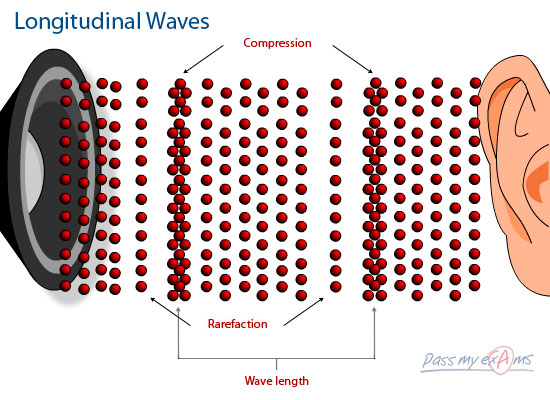What is Sound?
Sound is caued by mechanical vibrations transmitted through a solid, liquid and gas and travel as a wave.
Sound refers to those vibrations with frequencies detectable by the human ear. This is in the range 20 – 20,000 Hertz (Hz).
The animation of a vibrating diaphragm of a radio speaker below shows the generation and propagation of a sound wave.
| Sound Waves |
|---|
As the diaphragm of the speaker vibrates back and forth it disturbs the surrounding air molecules. The air molecules then pass on the disturbance to adjacent air molecules. In this way the originating disturbance from the speaker travels through air (the medium) via the air molecule as a sound wave. The air molecules do not themselves travel from the speaker to the ear rather they just vibrate to and fro. As the air molecules move in the same direction as the wave, sound waves are therefore longitudinal waves. |
The wavelength of a sound wave is the distance between successive compressions or rarefactions as shown in the diagram below.
 |
Wavelength: Distance between successive compressions or rarefactions. Compressions: Areas in the wave where the air molecules are pushed close together and so at a slightly higher pressure. Rarefaction: Areas in the wave where the air molecules are further apart and so at a slightly lower pressure. |
No Medium, No Sound
In order for sound waves to propagate there needs to be a medium to carry the disturbances produced by the vibrating object. In the case of sound waves in air the air molecules pass the disturbances on to adjacent air molecules. In water the water molecules act as the propagating medium and this is the case for any material i.e. glass, metals.
In regions such as space or in a vacuum sound waves cannot travel as there are no particles to convey the disturbance from the vibrating object. This can be demonstrated by a simple experiment by placing an alarm clock in a bell jar and removing the air.
Place an alarm clock in a bell jar connected to a vacuum pump with the alarm bell ringing. Start the pump to remove the air from the bell jar. As the air is being removed from the jar the sound of the alarm clock will slowly diminish. When all the air has been removed there will be will no sound produced from the alarm clock although the bell will still be vibrating. This demonstrates that sound waves cannot travel in a vacuum or in the absence of a medium. |
Reflection and Refraction of Sound Waves
The animations below describe reflection and refraction of sound waves.
